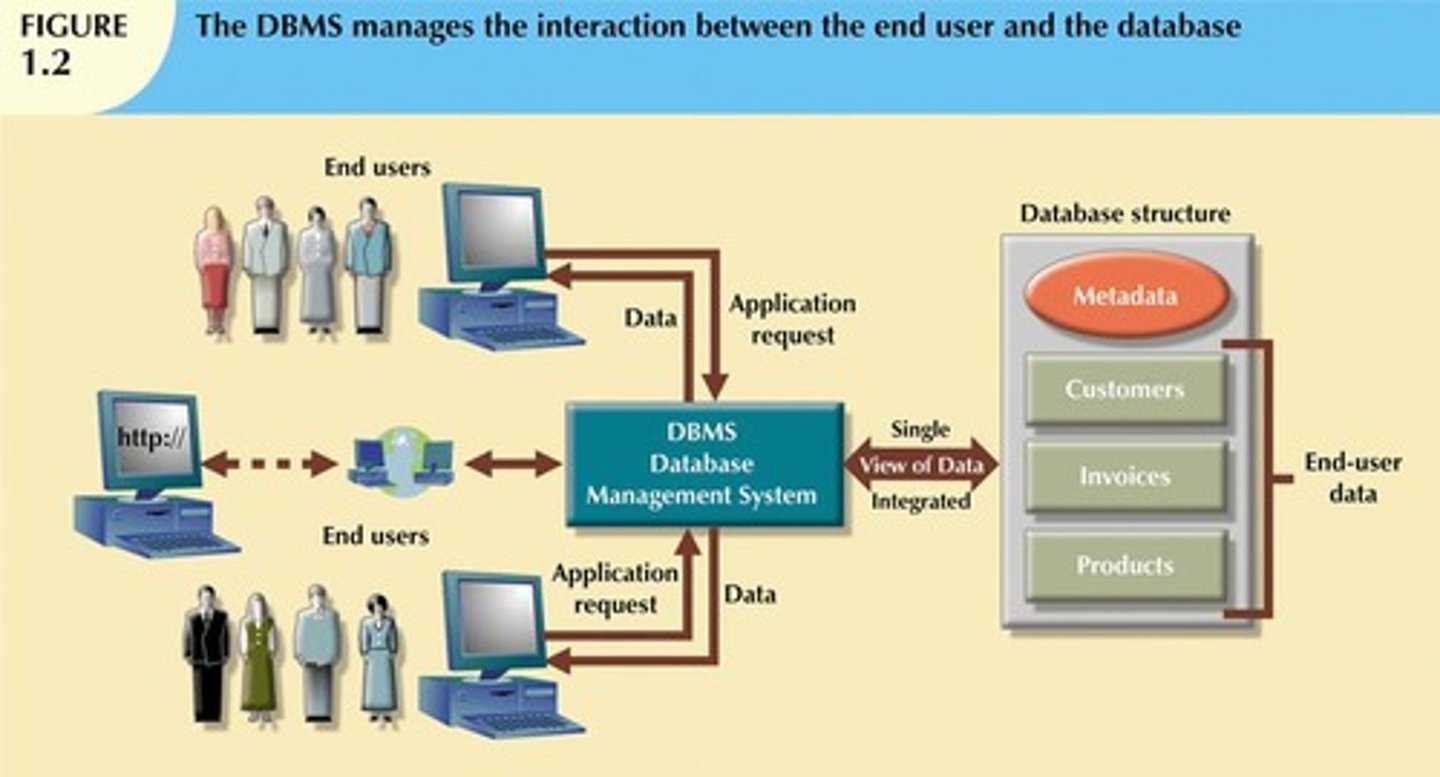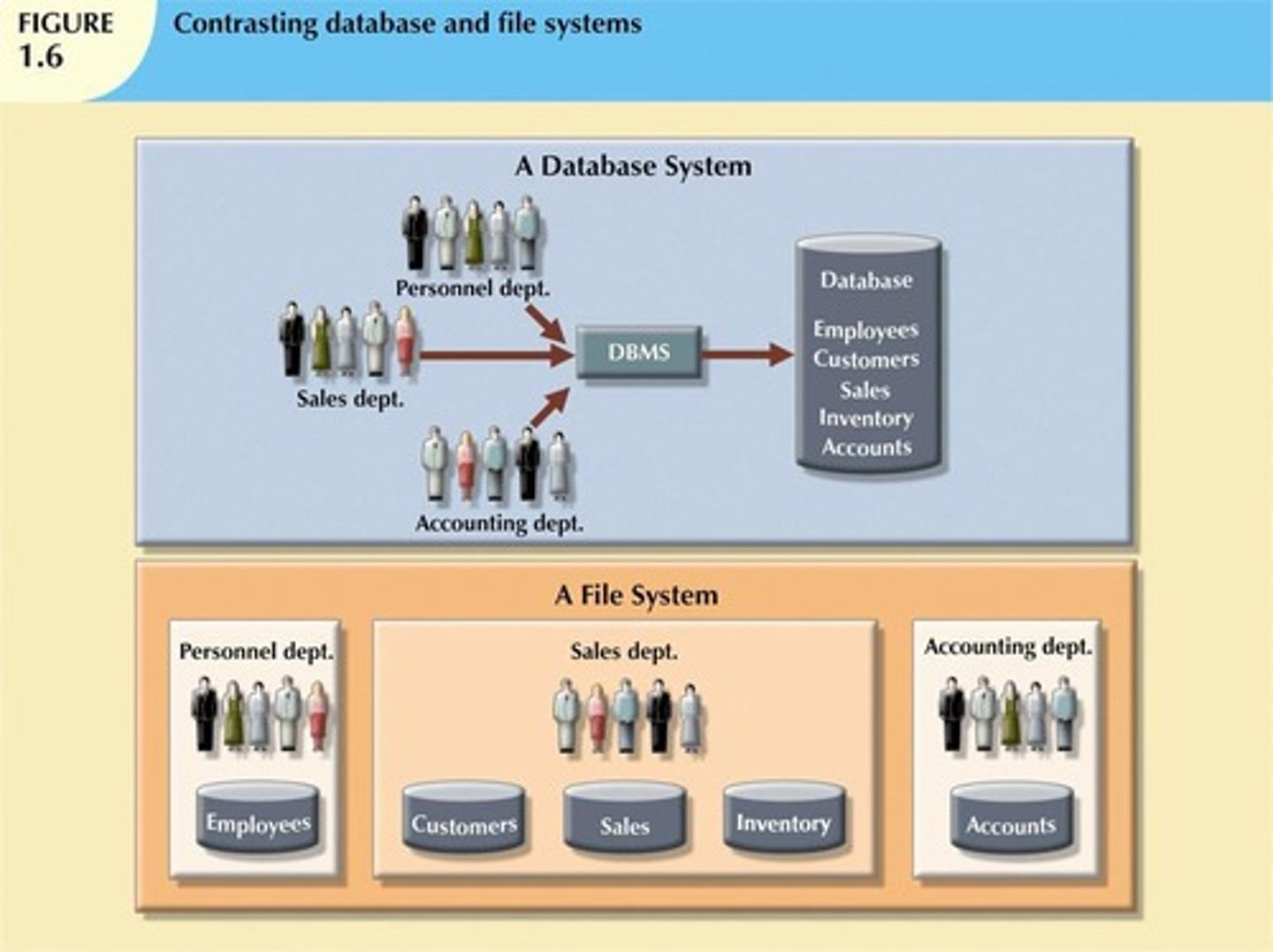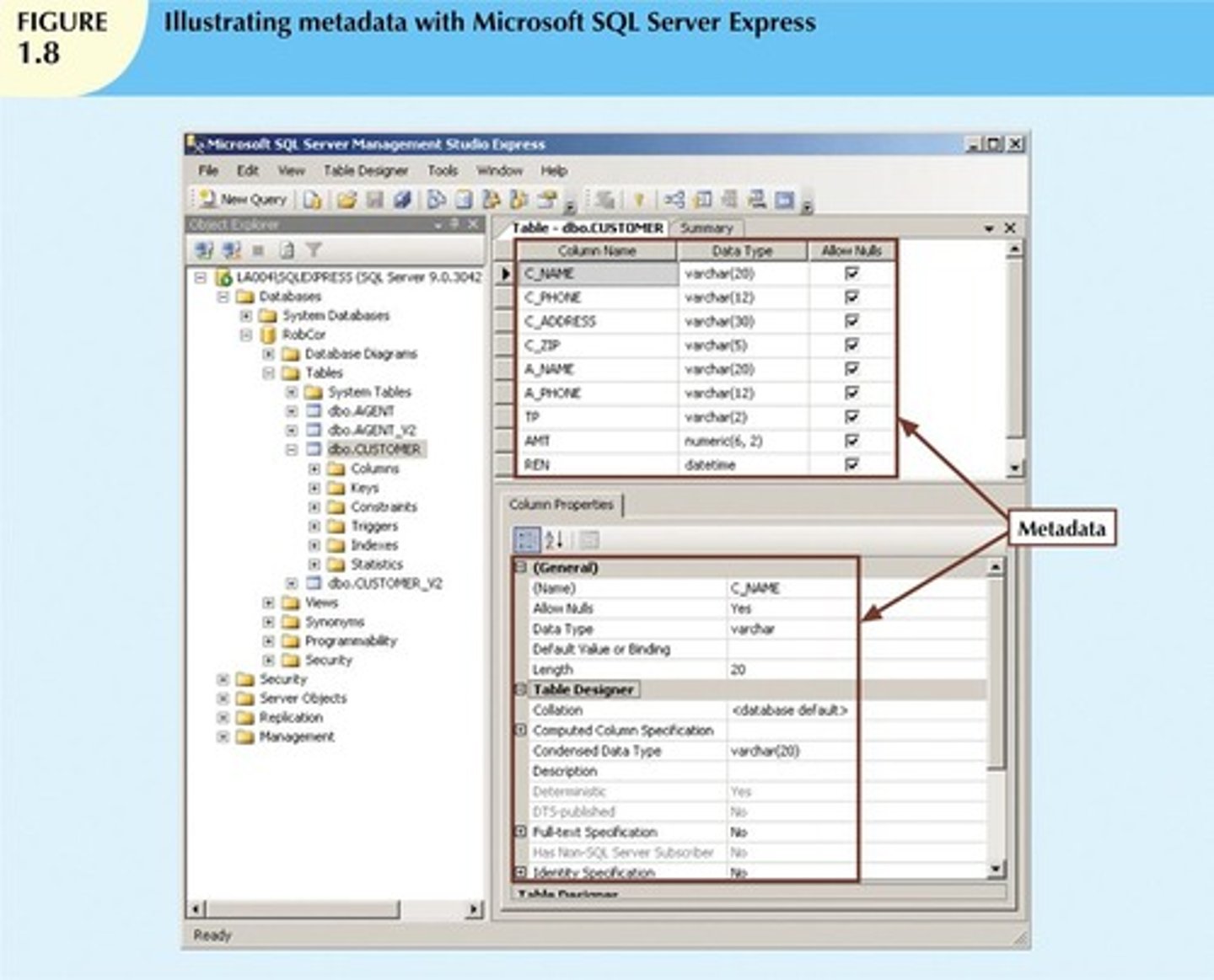Database Systems: Design, Management, and Evolution for Multiple Users
1/58
There's no tags or description
Looks like no tags are added yet.
Name | Mastery | Learn | Test | Matching | Spaced |
|---|
No study sessions yet.
59 Terms
What is the primary purpose of databases in data management?
Databases solve many problems encountered in data management and are used in almost all modern settings.
What are the key environments where databases are utilized?
Databases are used in business, research, and administration.
What is the difference between data and information?
Data are raw facts, while information is the result of processing raw data to reveal meaning.
What is required for raw data to become meaningful information?
Raw data must be formatted for storage, processing, and presentation, and it requires context to reveal meaning.
How do databases relate to file systems?
Databases evolved from computer file systems, and understanding file system characteristics is important for database management.
What is the foundation of information?
Data are the foundation of information, which is the bedrock of knowledge.
Why is it important to understand how databases work?
It is important to understand how databases work and interact with other applications for effective data management.
What are the building blocks of information?
Data
What is the role of information in relation to data?
Information is produced by processing data and is used to reveal meaning in data.
What type of information is key to good decision making?
Accurate, relevant, and timely information.
What is a database?
A shared, integrated computer structure that stores a collection of end-user data and metadata.
What is metadata?
Data about data that describes data characteristics and relationships.
What is a Database Management System (DBMS)?
A collection of programs that manages the structure and controls access to data.

What are the advantages of using a DBMS?
Improved data sharing, security, integration, minimized inconsistency, better access, improved decision making, and increased end-user productivity.
What distinguishes a single-user database from a multiuser database?
A single-user database supports only one user at a time, while a multiuser database supports multiple users simultaneously.
What is a centralized database?
A database where data is located at a single site.
What is a distributed database?
A database where data is distributed across several different sites.
What is the purpose of an operational database?
To support a company's day-to-day operations.
What is a data warehouse?
A database that stores data used for tactical or strategic decisions.
What is the difference between structured and unstructured data?
Structured data results from formatting, while unstructured data exists in its original state.
What is the significance of database design?
It focuses on the structure used for end-user data, facilitating management and generating accurate information.
What are the limitations of file systems in data processing?
They require extensive programming, cannot perform ad hoc queries, have complex administration, and have inadequate security features.

What is structural dependence in file systems?
Access to a file is dependent on its own structure, requiring modifications to programs when the structure changes.
What is data redundancy?
The unnecessary storage of the same data in different locations.
What are data anomalies?
Abnormalities that occur when changes in redundant data are not made consistently, including update, insertion, and deletion anomalies.
What are the five major parts of a database system?
Hardware, software, people, procedures, and data.
What types of software are required for a database system?
Operating system software, DBMS software, and application programs.
Who are the users of a database system?
System and database administrators, database designers, systems analysts, programmers, and end users.
What is the function of a data dictionary in a DBMS?
It stores definitions of data elements and relationships, providing metadata management.

What does data abstraction in a DBMS do?
It removes structural and data dependency, allowing users to interact with data without needing to understand its structure.
What is the significance of data independence?
Data storage characteristics do not affect data access, allowing for easier modifications.
What is the role of procedures in a database system?
They provide instructions and rules that govern the design and use of the database.
How does a DBMS improve decision making?
By providing accurate and timely information that enhances the quality of decisions.
What is the relationship between a DBMS and file systems?
A DBMS eliminates most of the problems associated with traditional file systems.
What is performance tuning in the context of a database?
Activities that make the database perform more efficiently.
How does a DBMS store a database?
In multiple physical data files.
What is the role of data transformation in a DBMS?
DBMS transforms data entered to conform to required data structures and transforms physically retrieved data to meet user's logical expectations.
What does security management in a DBMS involve?
Creating a security system that enforces user security and data privacy.
What determines user access in a DBMS?
Security rules that specify which users can access the database and which items can be accessed.
What is the role of multiuser access control in a DBMS?
It uses sophisticated algorithms to ensure concurrent access does not affect data integrity.
How does a DBMS manage backup and recovery?
It provides backup and data recovery mechanisms to ensure data safety and integrity, dealing with recovery after a failure.
What is data integrity management in a DBMS?
It promotes and enforces integrity rules, minimizes redundancy, and maximizes consistency, especially important in transaction-oriented database systems.
What is the significance of a data dictionary in a DBMS?
It stores data relationships used to enforce data integrity.
What is the standard query language used in most DBMS?
Structured Query Language (SQL) is the de facto query language supported by the majority of DBMS vendors.
How do current DBMSs facilitate database communication?
They accept end-user requests via multiple network environments, allowing users to generate answers through screen forms, publish reports on websites, and connect to third-party systems for information distribution.
What shift occurs in managing a database system?
The role of humans shifts from programming to managing the organization's resources, enabling more sophisticated use of data.
What are some disadvantages of database systems?
Increased costs, management complexity, maintaining currency, vendor dependence, and frequent upgrade/replacement cycles.
How does database design impact data management?
A well-designed database facilitates data management and generates valuable information, while a poorly designed database can lead to bad decision making and organizational failure.
What are some limitations of file system data management?
Requires extensive programming, complex system administration, difficulty in changing structures, inadequate security features, and redundancy in independent files.
What inherent weaknesses do DBMS address compared to file systems?
DBMS eliminate redundancy, enforce data integrity, and promote security, presenting the database as a single repository to end users.
What is the importance of accurate, relevant, and timely information?
It is key to good decision making.
What problems are associated with independent files in a file system?
They lead to structural and data dependency problems.
What does a well-designed database facilitate?
It facilitates data management and generates valuable information.
How does a DBMS promote data sharing?
By presenting the database to end users as a single repository, eliminating islands of information.
What are the consequences of a poorly designed database?
It can lead to bad decision making and organizational failure.
What is the primary function of a DBMS?
To implement a database and manage its contents.
What is the relationship between databases and file systems?
Databases evolved from manual and computerized file systems to address their inherent weaknesses.
What is the significance of enforcing data integrity in a DBMS?
It ensures the accuracy and consistency of data within the database.
What is the impact of redundancy in data management?
Redundant data can lead to inefficiencies and inconsistencies in information retrieval.